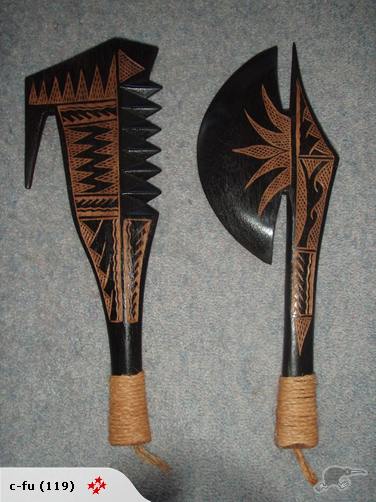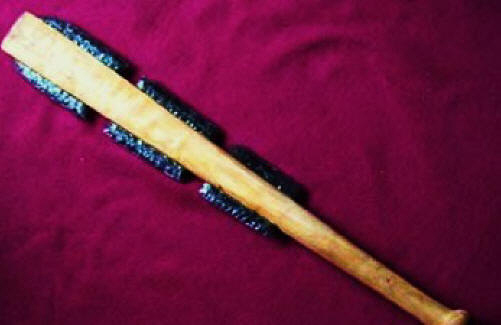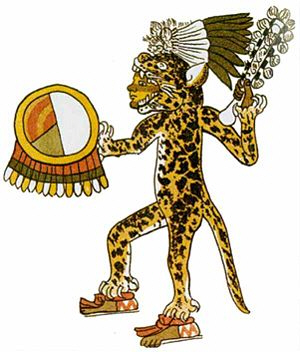
| myArmoury.com is now completely member-supported. Please contribute to our efforts with a donation. Your donations will go towards updating our site, modernizing it, and keeping it viable long-term.
Last 10 Donors: Anonymous, Daniel Sullivan, Chad Arnow, Jonathan Dean, M. Oroszlany, Sam Arwas, Barry C. Hutchins, Dan Kary, Oskar Gessler, Dave Tonge (View All Donors) |
| Author |
Message |
|
Dan P
Location: Massachusetts, USA Joined: 28 Jun 2007
Posts: 208
|
 Posted: Wed 30 Jul, 2008 6:40 am Post subject: Posted: Wed 30 Jul, 2008 6:40 am Post subject: |
 |
|
| Lafayette C Curtis wrote: |
Does anybody know the philosophy behind the armor's design? I'm thinking that the large screen mounted behind the head looks suspiciously like it's meant to ward of "friendly fire" from missile-throwers behind the wearer, but of course I don't know how far that idea is to the truth. |
I'm thinking head and neck protection, to cushion the strikes of blunt weapons.
When you think about it, that guy is basically wearing armor made of the same type of stuff that lots of people in Europe wore- only made of layers of coconut fiber and things rather than layers of linen and cotton.
|
|
  |
 |
|
Max Chouinard
Location: Quebec, Qc Joined: 23 Apr 2008
Posts: 108
|
|
   |
 |
Jean Thibodeau

|
 Posted: Wed 30 Jul, 2008 2:07 pm Post subject: Posted: Wed 30 Jul, 2008 2:07 pm Post subject: |
 |
|
| Max Chouinard wrote: | | Some Inuits wore the same type of armor, made out of ivory and whale baleen (like those Koryaks here: http://i5.photobucket.com/albums/y199/Comerus/armor.jpg ). The upper part was made to protect against arrow fire, the wearer would simply turn his back when a volley would come. Of course I suppose it could easily protect against other types of attacks. |
The high back should get in the way of a vertical or even angled attacks if the weapon used overextends the target
( head,neck and shoulders ).
I've speculated on other Topics, but without proof, that these kinds of armour might have been common in pre-history as it seems logical to use whatever is available for armour: Bone, wood, leather, fibres i.e. the idea of armour may be much older than commonly assumed.
You can easily give up your freedom. You have to fight hard to get it back!
|
|
  |
 |
Shahril Dzulkifli

|
 Posted: Wed 30 Jul, 2008 3:55 pm Post subject: The Wooden Weapons Thread. Posted: Wed 30 Jul, 2008 3:55 pm Post subject: The Wooden Weapons Thread. |
 |
|
|
Bennison, the Sioux war club's ball head as well as the spike are indeed metal. To me the 16 inch-tall Cocopah war club in the middle is undoubtedly the heaviest.
|
|
  |
 |
|
Marc Pengryffyn
Location: Canberra, Australia Joined: 21 Jul 2008
Posts: 72
|
 Posted: Wed 30 Jul, 2008 6:08 pm Post subject: Posted: Wed 30 Jul, 2008 6:08 pm Post subject: |
 |
|
| Jean Thibodeau wrote: | | Max Chouinard wrote: | | Some Inuits wore the same type of armor, made out of ivory and whale baleen (like those Koryaks here: http://i5.photobucket.com/albums/y199/Comerus/armor.jpg ). The upper part was made to protect against arrow fire, the wearer would simply turn his back when a volley would come. Of course I suppose it could easily protect against other types of attacks. |
The high back should get in the way of a vertical or even angled attacks if the weapon used overextends the target
( head,neck and shoulders ).
I've speculated on other Topics, but without proof, that these kinds of armour might have been common in pre-history as it seems logical to use whatever is available for armour: Bone, wood, leather, fibres i.e. the idea of armour may be much older than commonly assumed. |
A loooong time ago I read an account of native Americans using bark armor. I can't remember the source, and the details are pretty hazy, but I think they were from the Rocky Mountain or west coast regions, and the armor was worn for a sort-of ritualised combat between neighboring groups with a dispute to settle. To me it sounded like a combination of medieval tournament and judicial combat- partly for fun and the proving of courage and prowess, partly for settling honour and settling disputes. My memory is that the combat was done solely with missile weapons, I can't remember if it was bows or spears or rocks, and that honour would be considered satisfied once someone was injured or after a certain time had passed. I remember that the source stated that serious injuries were rare due to the armour. Sorry the details are so vague. I'll try to remember where I read it, and see if I've still got the book. I've read about similar pre-arranged tribal combats in the New Guinea highlands, but there the combat usually continued till someone was killed or seriously injured. No armor.
Hope this isn't too off-thread, I'm new here and not sure of the etiquette.
|
|
  |
 |
|
Max Chouinard
Location: Quebec, Qc Joined: 23 Apr 2008
Posts: 108
|
 Posted: Wed 30 Jul, 2008 9:58 pm Post subject: Posted: Wed 30 Jul, 2008 9:58 pm Post subject: |
 |
|
The Inupiat of Alaska that I was talking about had about the same way of doing things. They rarely went in melee combat, prefering to fight with arrows (and they had quite some bows, one was observed as having a force of 140 pounds if I remember). This was for more than honour and fun though, whale hunting was a very important part of their economy and battles were fought to control it.
Maxime Chouinard
Antrim Bata
Quebec City Kenjutsu
I don't do longsword
|
|
   |
 |
Bennison N

|
 Posted: Fri 01 Aug, 2008 2:13 pm Post subject: Posted: Fri 01 Aug, 2008 2:13 pm Post subject: |
 |
|
140 POUNDS?!
Geez... What did they make it out of and what did they string it with? That must have been some serious velocity at shorter ranges... I suppose if you're shooting prey through blubber, that would be ideal.
"Never give a sword to a man who can't dance" - Confucius
अजयखड्गधारी
|
|
  |
 |
|
Max Chouinard
Location: Quebec, Qc Joined: 23 Apr 2008
Posts: 108
|
 Posted: Fri 01 Aug, 2008 2:50 pm Post subject: Posted: Fri 01 Aug, 2008 2:50 pm Post subject: |
 |
|
I checked back in my books and it was 80 actually, I mixed it up with another, my mistake. saxton Pope tried one in 1923, it could go up to 180 yards. It wasn't the most powerful, but not the norm either, as you would need 40-50 pounds to wound a polar bear, and you don't hunt walrus with a bow. I have no idea though what strenght would have been found on war bows, as they had much better access to wood back there.
It was a type IV bow, considered one of the best Inuit bows (there are four main types identified by Hamilton) as it is equipped with ajustable sinews so it can work best in extreme cold. They are usually made of wood (drift wood, but preferably a spruce tree called Itkiq), either one piece or several with horn and/or ivory. Crossbows are also found, but they have not been very studied as of now, I've seen two of them in the CCM collections, both seemed to be made for small game hunt. http://www.civilization.ca/aborig/stones/ftoys/fG03661.htm
Here's a good website about type IV bows: http://www.kitikmeotheritage.ca/bowmaking/Intro/introduction.htm
Maxime Chouinard
Antrim Bata
Quebec City Kenjutsu
I don't do longsword
|
|
   |
 |
Bennison N

|
 Posted: Tue 05 Aug, 2008 4:02 pm Post subject: Posted: Tue 05 Aug, 2008 4:02 pm Post subject: |
 |
|
I was shopping on TradeMe, the New Zealand equivalent of EBay, and I found these Samoan Clubs. I didn't buy them, but I thought they were interesting and relevant to this thread.
These are very traditional shapes for war clubs in Samoa, or so my Samoan friend tells me. Isn't it interesting that the axe-shape, in general, spread everywhere across the globe? It seems to be universally known that that is an extremely effective shape for tools and weaponry.
Samoans are physically large and very strong... I would not want to see one running at me with either of these clubs...
Here's the picture:
 Attachment: 36.21 KB Attachment: 36.21 KB

Samoan Clubs.
"Never give a sword to a man who can't dance" - Confucius
अजयखड्गधारी
|
|
  |
 |
Jean Thibodeau

|
 Posted: Tue 05 Aug, 2008 5:34 pm Post subject: Posted: Tue 05 Aug, 2008 5:34 pm Post subject: |
 |
|
Bennision: Very attractive clubs and they seem like they would be effective but I wonder about the one on the left that has an extension on it's left side that seems like it could break off easily if one hit with the tip of it ? Just curious about the structural integrity of clubs like these ? Thick wood that is of a type that resists splitting along the grain might help ?
Maybe you can let us know a little bit about any special ways these would have been used ? Looks like some hooking would be part of the ways they would be used ?
Also, would thin wooden edges on the axelike one be actually capable of cutting and if not cutting the concentration of force might still break skin and do deep damage even if " cutting " might be more like heavy tearing and " mushing " of flesh: Sounds more painful than a cut by the way as well as bone crushing destruction.  ( YIKES ). ( YIKES ).
You can easily give up your freedom. You have to fight hard to get it back!
|
|
  |
 |
Bennison N

|
 Posted: Wed 06 Aug, 2008 3:30 am Post subject: Posted: Wed 06 Aug, 2008 3:30 am Post subject: |
 |
|
I've been told that the wood is very strong, I wasn't yet able to find out what exact type of wood it is, or if there are any treatments applied, however. The extension is for taking hold of other's weapons, and to toss them aside for a quick inside blow,a dear friend tells me. He tells me that you hook the opponent's weapon, toss it aside, and the tossing act itself disengages the hook. Sounds interesting... And here's the most interesting bit... These are used together, one in each hand, at the same time.
Samoans, as far as I can tell, never wore armour. They seem to have always fought bare-chested, or with woven clothing. That would lead me to believe, although I WILL research it more, that these weapons would do incredible damage with minimal effort.
That's all I can say without more research, but I will get back to you guys really soon with more info.
"Never give a sword to a man who can't dance" - Confucius
अजयखड्गधारी
|
|
  |
 |
|
James H.
|
 Posted: Wed 06 Aug, 2008 6:34 am Post subject: Posted: Wed 06 Aug, 2008 6:34 am Post subject: |
 |
|
The Maquahuitl of the Meso-american. I hope this pictures post alright. Here is a great web site that goes into researching these weapons, testing their effectiveness and how to make them also.
http://www.maquahuitl.co.uk/
I have to read up to find out how to post pictures, but the web-site is great info.[/img]
|
|
  |
 |
|
James H.
|
 Posted: Wed 06 Aug, 2008 6:46 am Post subject: Posted: Wed 06 Aug, 2008 6:46 am Post subject: |
 |
|
ok, lets try this, pictures are small but they are all I have at the moment, not sure but they might be considered stone weapons instead of wooden.
 Attachment: 50.17 KB Attachment: 50.17 KB

 Attachment: 45.89 KB Attachment: 45.89 KB

 Attachment: 25.9 KB Attachment: 25.9 KB

 Attachment: 74.99 KB Attachment: 74.99 KB

|
|
  |
 |
Bennison N

|
 Posted: Thu 07 Aug, 2008 2:24 am Post subject: Posted: Thu 07 Aug, 2008 2:24 am Post subject: |
 |
|
I recently did a comparative study of Aztec vs. Conquistador equipment and tactics for a paper I did for fun, and I found those Macahuitl to be very effective, if accounts I read were accurate...
I saw one Spanish account of a horse being beheaded by a single Macahuitl blow.
That's scary...
"Never give a sword to a man who can't dance" - Confucius
अजयखड्गधारी
|
|
  |
 |
|
James H.
|
 Posted: Thu 07 Aug, 2008 7:15 am Post subject: Posted: Thu 07 Aug, 2008 7:15 am Post subject: |
 |
|
|
Yeah, while I have never done any really heavy research into this stuff but i have always thought it was really amazing how evolved some of these societies became. Kind of a look at stone age technology as if the bronze age never came about. They did do metal work but mostly just for ornamentation or ceremonial reasons.
|
|
  |
 |
Shahril Dzulkifli

|
 Posted: Fri 08 Aug, 2008 4:53 pm Post subject: The Wooden Weapons Thread. Posted: Fri 08 Aug, 2008 4:53 pm Post subject: The Wooden Weapons Thread. |
 |
|
Here is a carved Wahaika, a short Maori club formerly used in battle. Although traditionally reserved for warriors of high status it is now often given as a gift to symbolize courage and determination.
Width: 5 inches / 13 cm
Length: 15.75 inches / 40 cm

|
|
  |
 |
Bennison N

|
 Posted: Mon 11 Aug, 2008 2:39 am Post subject: Posted: Mon 11 Aug, 2008 2:39 am Post subject: |
 |
|
Yeah... Wahaika are awesome weapons. They are very rarely made into tourist-item versions like other Patu are, showing the reverence Maori have for them. I have heard that Maori warriors using Wahaika sought each other out on the battlefield, and fought battles as a series of duels.
I wish it was possible to accurately describe the techniques possible with a Patu. I have fought a few guys who use wooden Mere, with a mujian, a simple wooden pole and a bokken, and despite the obvious differences in length, they invariably close the gap and actually give you a light crack on the skull.
They do have a lot of ritual placed on footwork, which I think actually takes away from the overall effectiveness, but the techniques are awesome, and particularly powerful with a stone Patu.
Some very limited explanation:
http://www.tki.org.nz/r/arts/dance/discover_d...nres_e.php
Some more Patu, mostly stone - from Te Papa Tongarewa (The Museum of New Zealand), in Wellington:
http://collections.tepapa.govt.nz/Search.aspx...;term=Patu
I wish this one, which is quite good, was slightly more in-depth, information-wise... please excuse the price tags!
http://www.giftsnz.com/weapons.htm
I am thinking I might have to get a actual Maori Taiaha fighter to come onto the thread and explain properly. I'll see what I can do...
"Never give a sword to a man who can't dance" - Confucius
अजयखड्गधारी
|
|
  |
 |
Shahril Dzulkifli

|
 Posted: Tue 12 Aug, 2008 12:51 am Post subject: The Wooden Weapons Thread. Posted: Tue 12 Aug, 2008 12:51 am Post subject: The Wooden Weapons Thread. |
 |
|

Here is a Supe club from Malaita Island in the Solomon Islands and is made from black palm and sinnet*.
Its length is 67x14cm (26.5x5.5in).
* Who knows what sinnet is?
Last edited by Shahril Dzulkifli on Wed 13 Aug, 2008 5:30 pm; edited 1 time in total
|
|
  |
 |
|
James H.
|
 Posted: Tue 12 Aug, 2008 7:03 am Post subject: Posted: Tue 12 Aug, 2008 7:03 am Post subject: |
 |
|
|
I think sinnet is what the handle is wrapped with, something like (sinew?) this is me making guess work though based on similar sounding names so don't take my word for it.
|
|
  |
 |
|
Marc Pengryffyn
Location: Canberra, Australia Joined: 21 Jul 2008
Posts: 72
|
 Posted: Tue 12 Aug, 2008 7:23 am Post subject: Posted: Tue 12 Aug, 2008 7:23 am Post subject: |
 |
|
"Sennit is a kind of flat cordage made by plaiting thinner strands of rope or grass."
and
"The term is also used in Hawaii and throughout Polynesia for cordage made by braiding the fibers of coconut husks."
from Wikipedia
http://en.wikipedia.org/wiki/Sinnet
Tradition is the illusion of permanence.
|
|
  |
 |
|
|
You cannot post new topics in this forum
You cannot reply to topics in this forum
You cannot edit your posts in this forum
You cannot delete your posts in this forum
You cannot vote in polls in this forum
You cannot attach files in this forum
You can download files in this forum
|
All contents © Copyright 2003-2024 myArmoury.com — All rights reserved
Discussion forums powered by phpBB © The phpBB Group
Switch to the Basic Low-bandwidth Version of the forum
|

